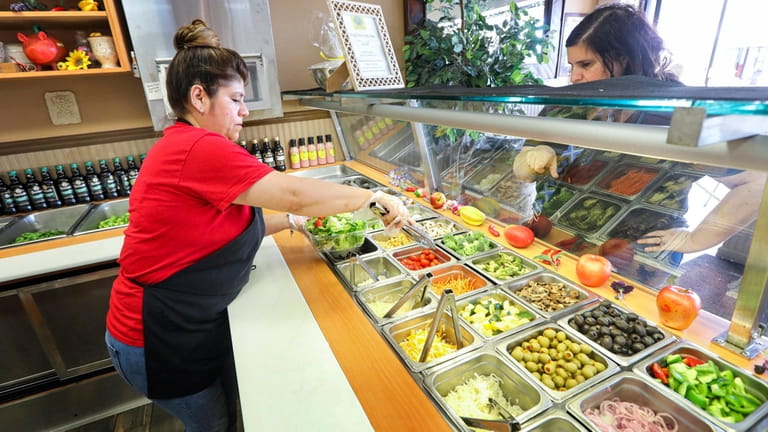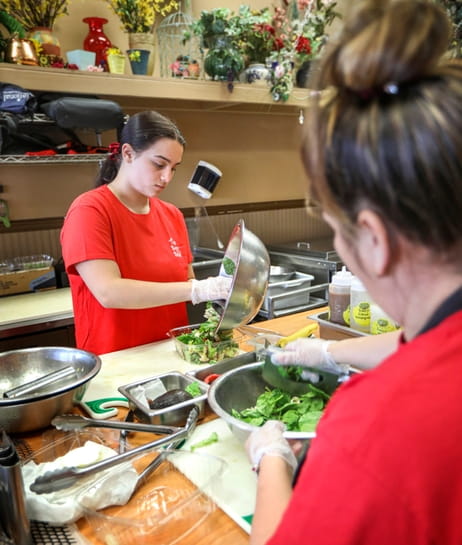Minimum wage workers surviving on food stamps as inflation rages

The $15-an-hour minimum wage seemed like a lofty goal when labor activists began the "Fight for $15" a decade ago. At the time, New York's minimum wage was $7.25.
But now that it's here — Long Island's minimum wage went from $14 to $15 on Dec. 31 — raging inflation has swallowed the increase, leaving many full-time workers in the region relying on food stamps to survive.
While low-wage workers have been hit hardest by rising costs, middle class families are also seeing their bills climb without matching increases to their salaries.
And employers are facing their own squeeze: The higher minimum wage and a record tight labor market are forcing them to raise wages at all levels to compete for workers, at the same time that inflation and supply chain issues are pushing up their other costs.
The net effect? Wage increases aren't keeping up with price increases. That means many Long Islanders, already struggling to keep up with the region's high cost of living, now find themselves losing ground to inflation.
For low-wage workers like Dawn Dimasi, just putting food on the table is a struggle.

'Food and bills and rent and all that, it doesn’t go really far.'
-Dawn Dimasi, 38, of Patchogue, who earns $15 an hour as a full-time employee at a home-based child-care business in Lake Ronkonkoma
Dimasi, 38, of Patchogue, earns $15 an hour as a full-time employee at a home-based child care business in Lake Ronkonkoma. At 40 hours a week, that's $31,200 a year before taxes.
“It falls short,” said Dimasi, who is a single mother to four children ages 2 to 17.
“Food and bills and rent and all that, it doesn’t go really far,” she said. “Thankfully I actually get help from food stamps because I can’t afford food with what I make … especially with three older boys and a toddler.”
Eligibility thresholds for New York State's Supplemental Nutrition Assistance Program (SNAP) vary by size of family and income. For example, a family of four earning up to $39,756 a year would qualify for the aid.
Dimasi said she knows that many large employers, like Target and Amazon, are offering higher starting wages.
“Retail is just not my thing,” she said. “Everyone told me that working with children, that’s where I belong. I like helping kids.”
Dimasi's boss, Darcel Leone, who has been a child care provider for over 30 years, said she would love to pay her more, but can't.

Darcel Leone, owner of the Darcy's Tots Daycare, with some of the children under her care at the facility, which is located in the basement of her Lake Ronkonkoma home. Credit: Newsday/John Paraskevas
Unlike most other industries that can pass on a portion of their increased cost of goods and wages to consumers, Leone said she is caught in a bind: Child care is already too expensive for many parents, limiting her ability to raise prices. That means staff wage increases are not possible right now, she said.
“We can only pay them minimum wage,” Leone said. “We know our staff is worth more than $15 an hour. It’s a very difficult industry, especially right now, and COVID didn’t help any.”
Like many child care workers, home health aides struggle at the bottom of the wage scale, earning an average of $31,590 a year — just above minimum wage, according to Labor Department estimates.
Kristy, 25, of Bellport, an aide who asked that her last name not be used for fear of reprisal from her employer, said her low salary forces her and her 2-year-old twin boys to live with her mother. They also use food stamps.
Kristy called the $15.22 she earns per hour "ridiculous" for the work she does. She has worked as a home health aide and in nursing homes since she finished high school.
“I say it’s ridiculous because I have my two sons,” she said. “You expect someone to provide for them bringing home $400 a week?" That's what she makes after taxes and health insurance premiums.
"That’s not something that’s easy," she said. "I honestly don’t even know how I do it sometimes.”
Who makes minimum?
Few statistics are available on Long Island's minimum wage workers. But state and national numbers paint a picture. Most in New York — 57% — are female, according to a 2019 report from the New York State Division of the Budget, and about 40% are estimated to work in the hospitality or retail industries. Few — just 6% nationwide — are teenagers, while 80% are 25 or older, Bureau of Labor Statistics data shows.
The reality for them, and for most workers, is that increases in their wages are falling behind inflation, leading to a reduction in purchasing power, said Gregory DeFreitas, labor economist and professor at Hofstra University.
“Workers need higher wages, and they and their families are being challenged by price inflation,” he said.
Wages across the country have been in a state of "pay paralysis" for roughly 40 years, DeFreitas said, calling the current upward pressure on wages caused by the pandemic a major turning point for workers.
“Employers, on average, have had a bargain on labor for a really long time," he said. “Really, wages for about 90% of American workers on average have been stagnant. It’s only during the late '90s boom and now that we’ve had some serious national upward pressure on wages."
In general, he said, workers — especially lower-paid workers — have come out of the pandemic wanting higher compensation, better benefits and more flexibility.
“It's total free market economics,” DeFreitas said. “Employers are subject to market conditions, and if they want the best workers they have to have a job offer to attract them.”
Still, the current rate of inflation is overtaking those higher wages. Data from the Bureau of Labor Statistics shows average hourly earnings of U.S. workers were up 5.5% in April compared to a year ago — a healthy increase in normal times, but well below April's skyrocketing national inflation rate of 8.3%.
Ripple effect on wages
On the Island, the latest minimum wage bump from $14 to $15 — a 7% increase — was running neck and neck with the local inflation rate of 6.3%. The increase was a help for workers earning at that level, and business owners point out that the mandated increase created a ripple effect up the ranks of their organizations.
“Obviously, as minimum wage has gone up, it’s not just your minimum wage people that are impacted, it’s everybody who's making $17 or $18,” said Mark Wolf, president of Contract Pharmacal Corp., one of the largest drugmakers on Long Island. “So those people have to have their pay increase by that substantial rate.”

Mark Wolf, president of Contract Pharmacal Corp. in Hauppauge, says raising wages has helped the company recruit workers. Credit: Jessica Rotkiewicz
“Prior to COVID it was still hard to find employees,” Wolf said. “It’s harder today, but I think it’s getting a little easier for the fact that I have raised wages.”
He declined to reveal the new pay ranges but said “that has substantially increased my costs.”
Business owners say the dearth of job candidates has made raising wages the only way to attract and retain workers. In March, the latest month such data is available, employers had posted a record 11.5 million job openings — roughly two open positions for every one unemployed American, according to the Bureau of Labor Statistics.
“When we talk about it with our business owners, we come across two key points and themes. One is the [limited] talent pool that they have access to,” said Shawn Klotsche, a financial adviser and analyst at the Wealth Alliance, a Melville finance and investments advisory firm.
“On top of that there are many, many large companies that are increasing their minimum wage on top of the minimum wage set by the government,” Klotsche said.
Over the past year, large national employers like Amazon, Target, Walmart and Bank of America have made headlines over plans to increase worker pay. Earlier this year, Target said that it would begin offering minimum wages of $15 to $24 in competitive markets like New York. In the fall, Bank of America raised its nationwide minimum hourly wage to $21.
Nine out of 10 employers nationwide said they planned to give base pay increases this year, according to a Payscale survey of more than 5,500 employers from November to January.
Yet despite 76% of businesses saying they faced labor shortages and challenges to attracting employees last year, only 44% of businesses said they planned to raise wages more than 3%, falling well below the pace of inflation, the survey found.
At the same time the labor market is putting upward pressure on wages, business owners are caught in their own inflation bind. The cost of raw goods has only increased, and external factors, like the Russian invasion of Ukraine and ongoing pandemic supply chain issues, have made doing business more expensive across the board.
U.S. producer prices soared 11% in April compared with the same month in 2021, according to recent figures from the Bureau of Labor Statistics.
Employers see raises pay off
For some business owners, the pressure to increase wages while also coping with other rising costs has meant having to rethink their operations, find efficiencies and adjust their prices.
One restaurateur said those steps have paid off.

Employee Elba Perez works on a customer’s salad order at the Sexy Salad restaurant in Hauppauge. Credit: Newsday/John Paraskevas
Raising wages “was a great thing for my company,” said John Robertson, owner of the Sexy Salad restaurant in Hauppauge. “We are in a much better position and increased wages had a big part in that.”
“It’s a much more quality workforce now than it ever was before,” he said.
Robertson said that prior to the pandemic he had more than 25 employees.
Since then, after having to lay off his employees during the worst of the pandemic, he's cut down on the number of staff.

'My 15 employees right now are being paid more than they ever have before.'
-John Robertson, owner of the Sexy Salad restaurant in Hauppauge
”My 15 employees right now are being paid more than they ever have before,” Robertson said. “The majority of them are making 25% more" than they were before the pandemic.
Workers before the pandemic were making $12 to $13 an hour and are now making $16 to $18 an hour, he said. His highest paid employee saw hourly pay go from $18 pre-pandemic to $25 now.
He said those wage increases have meant he's had to raise prices. But it's a trade-off many of his customers understand, and one he feels is justified.
”We absolutely raised prices,” he said. “And the customers, they know everything that is going on and they are more than happy to pay for quality employees.”
At the Southampton Inn, paying employees the minimum wage hasn't been an option for years given the competition for hospitality workers in the Hamptons, said Dede Gotthelf, chief executive of Southampton Cat Cove LLC, owner of the inn.
“Whatever the government-mandated minimum wage may be, as a business owner and as a company that is heavily reliant on its human resources to provide the proper service for our customers, we do offer a little bit more by giving a living wage rather than minimum wage,” Gotthelf said.
“We’re somewhere between $17 and $20 for some of our hourly employees,” she said.
Attracting service workers in an area with limited affordable housing has posed challenges for Gotthelf, but a major key has been raising wages.
“We’ve been increasing wages every year, but certainly in the last two years, we’ve needed to keep up and be competitive," she said.
